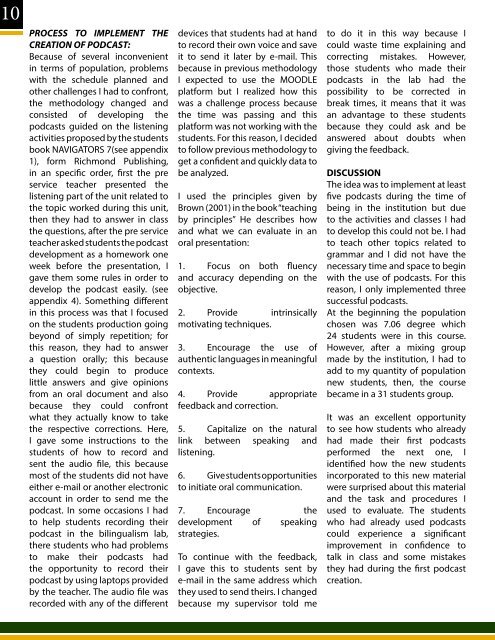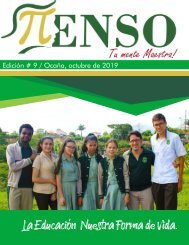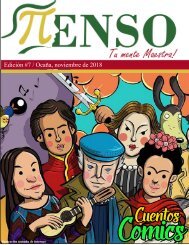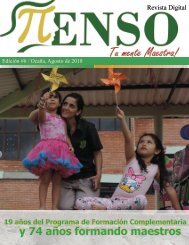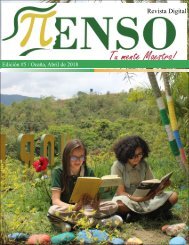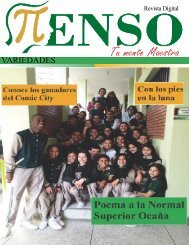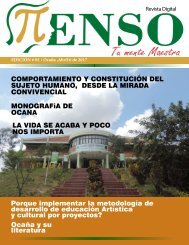Create successful ePaper yourself
Turn your PDF publications into a flip-book with our unique Google optimized e-Paper software.
10<br />
PROCESS TO IMPLEMENT THE<br />
CREATION OF PODCAST:<br />
Because of several inconvenient<br />
in terms of population, problems<br />
with the schedule planned and<br />
other challenges I had to confront,<br />
the methodology changed and<br />
consisted of developing the<br />
podcasts guided on the listening<br />
activities proposed by the students<br />
book NAVIGATORS 7(see appendix<br />
1), form Richmond Publishing,<br />
in an specific order, first the pre<br />
service teacher presented the<br />
listening part of the unit related to<br />
the topic worked during this unit,<br />
then they had to answer in class<br />
the questions, after the pre service<br />
teacher asked students the podcast<br />
development as a homework one<br />
week before the presentation, I<br />
gave them some rules in order to<br />
develop the podcast easily. (see<br />
appendix 4). Something different<br />
in this process was that I focused<br />
on the students production going<br />
beyond of simply repetition; for<br />
this reason, they had to answer<br />
a question orally; this because<br />
they could begin to produce<br />
little answers and give opinions<br />
from an oral document and also<br />
because they could confront<br />
what they actually know to take<br />
the respective corrections. Here,<br />
I gave some instructions to the<br />
students of how to record and<br />
sent the audio file, this because<br />
most of the students did not have<br />
either e-mail or another electronic<br />
account in order to send me the<br />
podcast. In some occasions I had<br />
to help students recording their<br />
podcast in the bilingualism lab,<br />
there students who had problems<br />
to make their podcasts had<br />
the opportunity to record their<br />
podcast by using laptops provided<br />
by the teacher. The audio file was<br />
recorded with any of the different<br />
devices that students had at hand<br />
to record their own voice and save<br />
it to send it later by e-mail. This<br />
because in previous methodology<br />
I expected to use the MOODLE<br />
platform but I realized how this<br />
was a challenge process because<br />
the time was passing and this<br />
platform was not working with the<br />
students. For this reason, I decided<br />
to follow previous methodology to<br />
get a confident and quickly data to<br />
be analyzed.<br />
I used the principles given by<br />
Brown (2001) in the book “teaching<br />
by principles” He describes how<br />
and what we can evaluate in an<br />
oral presentation:<br />
1. Focus on both fluency<br />
and accuracy depending on the<br />
objective.<br />
2. Provide intrinsically<br />
motivating techniques.<br />
3. Encourage the use of<br />
authentic languages in meaningful<br />
contexts.<br />
4. Provide appropriate<br />
feedback and correction.<br />
5. Capitalize on the natural<br />
link between speaking and<br />
listening.<br />
6. Give students opportunities<br />
to initiate oral communication.<br />
7. Encourage the<br />
development of speaking<br />
strategies.<br />
To continue with the feedback,<br />
I gave this to students sent by<br />
e-mail in the same address which<br />
they used to send theirs. I changed<br />
because my supervisor told me<br />
to do it in this way because I<br />
could waste time explaining and<br />
correcting mistakes. However,<br />
those students who made their<br />
podcasts in the lab had the<br />
possibility to be corrected in<br />
break times, it means that it was<br />
an advantage to these students<br />
because they could ask and be<br />
answered about doubts when<br />
giving the feedback.<br />
DISCUSSION<br />
The idea was to implement at least<br />
five podcasts during the time of<br />
being in the institution but due<br />
to the activities and classes I had<br />
to develop this could not be. I had<br />
to teach other topics related to<br />
grammar and I did not have the<br />
necessary time and space to begin<br />
with the use of podcasts. For this<br />
reason, I only implemented three<br />
successful podcasts.<br />
At the beginning the population<br />
chosen was 7.06 degree which<br />
24 students were in this course.<br />
However, after a mixing group<br />
made by the institution, I had to<br />
add to my quantity of population<br />
new students, then, the course<br />
became in a 31 students group.<br />
It was an excellent opportunity<br />
to see how students who already<br />
had made their first podcasts<br />
performed the next one, I<br />
identified how the new students<br />
incorporated to this new material<br />
were surprised about this material<br />
and the task and procedures I<br />
used to evaluate. The students<br />
who had already used podcasts<br />
could experience a significant<br />
improvement in confidence to<br />
talk in class and some mistakes<br />
they had during the first podcast<br />
creation.


